Experimental and clinical perspectives on glycocalyx integrity and its relation to acute respiratory distress syndrome
IF 4.2
2区 生物学
Q2 BIOCHEMISTRY & MOLECULAR BIOLOGY
Biochimica et biophysica acta. Molecular basis of disease
Pub Date : 2025-02-22
DOI:10.1016/j.bbadis.2025.167745
引用次数: 0
Abstract
The development of microcirculation imaging devices has significantly advanced our comprehension of the capillary environment's dynamics. Early research suggested that erythrocytes did not contact the vessel's inner surface due to the Fåhraeus effect, implying the presence of a covering on the endothelial cell surface. Subsequent electron microscopy studies revealed this layer to be a complex part of the vessel wall, now known as the endothelial glycocalyx (EG). The EG is a network of proteoglycans and glycoproteins bound to the endothelial membrane, incorporating soluble molecules from the endothelium and plasma. Over time, studies have elucidated the structure, function, and therapeutic targets of the glycocalyx, underscoring its pivotal role in vascular biology. The presence of cellular extensions of lung tissue cells in both vascular and nonvascular areas demonstrates the pivotal role of the glycocalyx in pulmonary vascular leak, surfactant dysfunction, impaired lung compliance and gas exchange abnormalities, which are hallmarks of acute respiratory distress syndrome (ARDS). It is of the utmost importance to elucidate the mechanisms underlying alveolocapillary glycocalyx degradation to develop efficacious treatments for ARDS, which has a mortality rate of 35 %. An understanding of the glycocalyx's role in vascular integrity provides a foundation for exploring new therapeutic avenues to mitigate lung injury and improve clinical outcomes in ARDS patients.
求助全文
约1分钟内获得全文
求助全文
来源期刊
CiteScore
12.30
自引率
0.00%
发文量
218
审稿时长
32 days
期刊介绍:
BBA Molecular Basis of Disease addresses the biochemistry and molecular genetics of disease processes and models of human disease. This journal covers aspects of aging, cancer, metabolic-, neurological-, and immunological-based disease. Manuscripts focused on using animal models to elucidate biochemical and mechanistic insight in each of these conditions, are particularly encouraged. Manuscripts should emphasize the underlying mechanisms of disease pathways and provide novel contributions to the understanding and/or treatment of these disorders. Highly descriptive and method development submissions may be declined without full review. The submission of uninvited reviews to BBA - Molecular Basis of Disease is strongly discouraged, and any such uninvited review should be accompanied by a coverletter outlining the compelling reasons why the review should be considered.

 求助内容:
求助内容: 应助结果提醒方式:
应助结果提醒方式:


